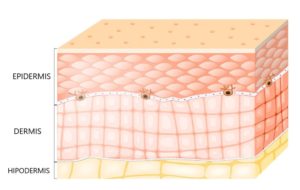Of all the body’s organs, the skin is the most versatile of all. It is the only organ that is directly and constantly open to the outside. The skin protects from external agents, from heat and cold, from the air and the elements, from bacteria, it is waterproof, it repairs and lubricates itself, it even removes some waste from the body.
The skin can warn of internal diseases with changes in its color or texture, with the appearance of pimples or spots. Provides the sense of touch, it can be rough or delicate, smooth or wrinkled, depending on needs or age.
It may bristle, blister, tingle, itch, hurt, sweat, stretch, shrink, bleed, and blush. The skin contributes to the production of vitamin D, vital for bone and joint health. Control body temperature. It can show emotions, is a source of social and sexual attraction and denotes racial origin. “The skin of an average adult covers almost two square meters and weighs more than two and a half kilos”
What is skin?
The skin of an average adult covers almost two square meters, weighs just over two and a half kilos and sheds around nineteen kilos of dead cells throughout life.
The skin has a complex structure made up of two different layers: the epidermis and, under it, the dermis.

The epidermis is variable in thickness, from a millimeter on the palms of the hands and soles of the feet, where protection against pressure is the most important, to a tenth of a millimeter on the face, eyelids and lips, where precision is needed. and speed in the movements.
The epidermis does not contain red blood cells, but produces melanin, which darkens the skin to protect it from the sun. The pinkish color of people with fair skin is influenced by the red color of the blood cells and by carotene, which filters sunlight.
In the deepest part of the epidermis, young cells, which are oval, smooth and soft, constantly divide and rise to the surface approximately every twenty-eight days.
Under the epidermis is the dermis, a fibrous layer, thicker in men than in women, coarser on the back and variable in thickness (between half a millimeter and three). It is full of collagen, which with its elastic fibers gives the skin strength and elasticity.
The dermis feeds the production of keratin , extracts waste and regulates body temperature. Several thousand nerve endings play an essential role in the sense of touch sensing cold, heat, pressure and pain.
There are also pockets of hair follicles, where the sebaceous glands secrete sebum, an oily substance that makes the skin supple and the hair shiny.
The hair on the head insulates, the eyelashes and the hairs on the nose and ears protect from foreign objects and the eyebrows help prevent sweat from reaching the eyes. “Emotional problems can also cause skin problems”
Why does the color of the skin vary?
The amount and distribution of the dark pigment (melanin) determines the color of the skin, and its variations reflect the body’s adaptation to different environments.
Black skin, for example, helps protect against sunburn. Scandinavians have pale skin to avoid vitamin D deficiencies in an environment where sunlight is low. Albinos lack the gene that makes melanin.
Although the skin has an incredible ability to maintain itself, resist the sun, wind, water and many types of bad practices such as tattoos or excessive hygiene, it is prey to many disorders, infections and diseases.
Six square centimeters can host up to six million bacteria. Emotional problems can also lead to skin problems.
Skin problems
People with skin problems represent ten percent of all patients who see family doctors.
The reasons for consultation are rarely considered “serious” but can cause pain or even disability, as well as social and emotional problems.
Skin diseases are often transmitted from generation to generation, but the fact that they are inherited does not mean that they are incurable or that they cannot be treated satisfactorily.
The most common skin problems are:
- Viral infections
- Ezzemas
- Psoriasis
- Acne
- Yeast infections
- Skin cancer
- Urticaria
- Alopecia
- Moles
“The greatest risk to the skin is excess sunlight, which can lead to premature aging or even skin cancer.”
Take care of your skin The skin is so wonderfully self-sufficient that we can come to think that we have it guaranteed forever or that we can abuse it without problems. But it deserves and requires proper care, especially as we get older.
The skin should be kept clean, but washing it excessively with soap will dry it out, depriving it of its natural lubricant: sebum. Soap can also cause allergic reactions. If that happens, we must choose a product marked as ” hypoallergenic “. Moisturizing products help to lubricate the skin with a film of oil and water emulsion, and are not absorbed beyond the outermost layer of the skin.
The biggest risk to the skin is excess sunlight. Excessive exposure causes not only dryness or burns, but long-term changes that can lead to premature aging or even skin cancer.
A broad spectrum of sunscreens with a protection factor of at least 15 (30 for children), blocks most of the harmful ultraviolet radiation. Sunscreens should be applied before going out in the sun and reapplied every two hours, they should be applied generously, most people don’t apply enough.
It must be taken into account that, even products prepared to resist water, go away with the use of a towel.






